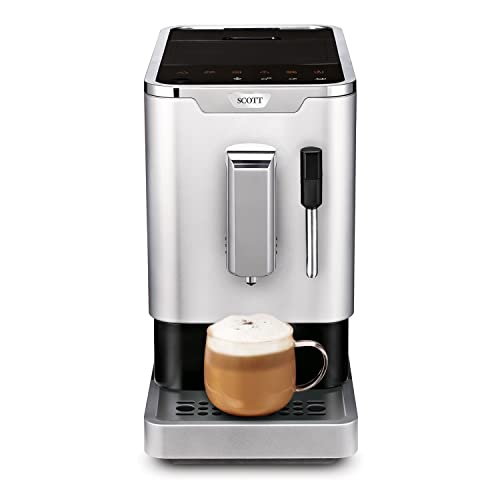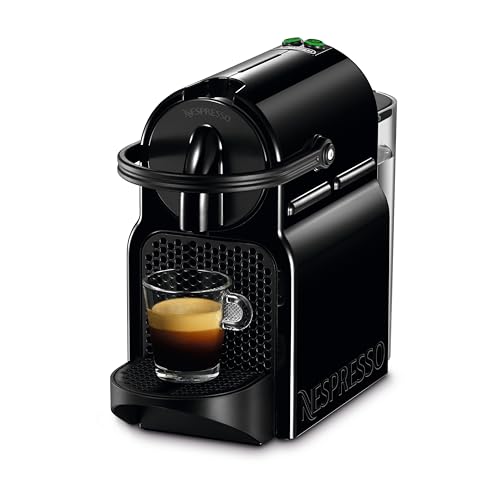
Andrea Gill @ coffeee0967 Member Since: 09 Oct 2024
 Germany
Germany
About Me
The 10 Scariest Things About Coffee Maker Machine
Features of a Coffee Maker Machine Millions of Americans begin their day with a cup of coffee prepared in a coffee maker machine. These countertop appliances are easy to use and require little maintenance.
Millions of Americans begin their day with a cup of coffee prepared in a coffee maker machine. These countertop appliances are easy to use and require little maintenance.A coffee maker functions by heating water and dripping it over coffee grounds. The majority of models come with a carafe that can hold several cups of coffee as well as an electric warming plate.
Temperature Control
The temperature of the water that is used in the coffee maker is crucial to the aroma and flavor your cup of joe will be infused with. A coffee maker that can automatically maintain the ideal temperature for brewing is the best option. The flavor of coffee will change as the temperature changes from bitter to sour.
The ideal temperature to brew coffee is between 197F (F) and 204F (F). This temperature allows the coffee beans to be completely extracted without burning or scorching the grounds. A coffee maker that has a temperature control feature will ensure that your brew will be at the right serving temperature, regardless of the type of coffee or blend you choose to use.
Other features to look out for in a coffee maker are an enormous reservoir of water and an adjustable filter basket. This will allow you to make a large batch of coffee without having to keep refilling the carafe. It can also be an ideal feature for families who consume multiple cups of coffee throughout the day. A timer that can be programmed is a useful feature that could assist you in setting your coffee to be ready at the desired times.
Some coffee makers have an extra function that allows you to alter the strength of your coffee to meet your preferences. This is a great feature for those with specific requirements when it comes to their coffee's taste or those who like to brew different strengths each day. Some coffee machines have a thermally-induced pressure feature which produces an additional extraction. This can lead to a smoother taste than traditional drip brewing.
Certain coffee makers come with hotplates that keep the coffee warm for a lengthy time. This feature is extremely useful for those who are making multiple cups of coffee, as it allows you to have your first cup ready before the others finish brewing. Some coffee makers let you control the temperature of the plates so that it does not cause burns to your hands.
Water Level Indicator
Monitoring the level of water in a reservoir or tank is vital. It is crucial for the household to function in a proper manner, both in terms of drinking water as well as water for other purposes. It also helps in avoiding undesirable incidents like leakage and water overflow from overhead tanks.
A simple circuit for measuring water levels can be used in order to detect the presence or absence of water inside the tank. It is comprised of a sensor connected to the microcontroller. The circuit can be easily constructed using a few basic electronic and electrical components. It is easy to use and doesn't require any complicated programming. The water level circuit is suitable in a variety of applications for example, the detection of leakage or overflow, or even flooding.
When you start your coffee maker in the morning, you're likely not thinking about what is going on inside the machine. How does the water get so hot and what is the sound that is gurgling? There's a lot of science involved.
The base of the coffee maker has an water reservoir which you can fill with water. The tube that runs from the bottom to the top of your machine is known as the drip area. The hot water tube is inserted into this, and the hot water is pumped through a perforated disc, called the drip area. The hot water drips onto the grounds of the coffee, which fills the carafe.
A sensor is connected to the base transistor in order to determine the water level. The sensor is composed of a power and sense trace, which create a variable resistor which changes in proportion to the amount of water they're immersed in. This is because the more water they are exposed to, the greater their conductivity which means they have lower resistance. The sensor also produces a voltage based on this conductivity, which can be measured to determine the water level.
When water is in contact with probe A, positive voltage is applied to the base of transistor Q1. This makes the transistor switch ON, and current flows from its collector to its emitter, causing LED 1 glow. When the water reaches probe B the transistor Q2 switch ON is activated. When the water reaches probe C, the switch ON of transistor Q3 is activated, and when it reaches probe D, the buzzer will be activated.
Brewing Timer
A coffee maker timer permits you to set a time limit before the machine starts making coffee. This feature is great for those who prefer to prepare their coffee ahead of time and don't wish to get up at the crack of dawn to make a cup.
There are several types of coffee machines with timers for brewing. They include single-serve coffee makers and pod coffee makers. Single-serve coffee machines dispense pre-ground and measured cups of coffee directly into your cup without the necessity of filters. They're convenient, but they may be a bit more costly than traditional drip coffee makers.
The pod coffee makers are small, single-use filters that hold ground coffee. The hot water runs through the grounds before it reaches your mug, and the pods are discarded after they're depleted. Pod coffee makers are simple to use and are a good option for people who don't have lots of extra space in their kitchen.
If you're looking to buy a larger capacity coffee maker, there are also coffee makers that can be used to brew multiple cups at once. Some models come with a glass cup that keeps your coffee warm until it's time to serve. Certain models have an insulated reservoir that makes it easier to refill the machine.
To make a better coffee, you can make use of a coffee maker that has an integrated scale. These machines calculate the amount of water and coffee required to achieve the desired quantity. This helps you keep all the ingredients in your kitchen. Many of these models have built-in timers for coffee brewing also which means you can be sure your coffee will be ready by a certain time.
A coffee maker with a built-in timer can assist you in avoiding overbrewing which can lead to bitterness and strong aromas. A timer will notify you when the brewing process is completed, and some even sound an audible alarm when it's time for you to stop brewing. This feature is particularly helpful for those who like to use third-wave methods such as the Aeropress or Hario V60.
Easy Cleaning
Many of the best models of coffee makers have an automatic self-cleaning cycle. This feature lets you run a mixture of water and vinegar through your machine whenever the buildup of scale reaches a certain level, which helps protect the machine and keeps your coffee tasting fresh. Cleaning indicator lights usually alert you when the auto-cleaning process is required.
Another method to keep your coffee maker smelly and tasting great is to regularly clean the removable parts of your machine Milos says. Remove the permanent filter and brew basket from the machine and wash them in soapy, hot water. Rinse thoroughly to eliminate any coffee grounds that remain or oily residue. Wipe down the outer shell as well as the inner lid using a damp cloth soaked in warm water and dishwashing detergent. Then, rinse with warm water and allow it to dry before putting it back together.
Vinegar can also help descale the coffee maker and also remove mineral deposits. If you don't wish to use vinegar, you can try a solution made of equal parts white vinegar and water. Start the brewing process however, stop it at the halfway point to allow the vinegar to penetrate the scale. Then, run a full cycle of water through the coffee maker to wash the vinegar solution as well as any scale.
Cleansing your coffee maker will help it last longer, Milos says. It is recommended to clean your coffee maker's reservoir and the pot every three to four months, and the removable parts every time you use it. Cleaning a coffee maker isn't difficult, but it is important to include it in your regular home cleaning schedule so you can drink your favorite cup of coffee in confidence that your machine is free of mold and other contaminants.
 While it's easy to concentrate on the key features of the coffee maker, don't overlook its simple maintenance, which can determine the success or failure of your morning ritual. These tips will ensure that your coffee maker is operating optimally, regardless of whether you use an Keurig or drip coffee maker.
While it's easy to concentrate on the key features of the coffee maker, don't overlook its simple maintenance, which can determine the success or failure of your morning ritual. These tips will ensure that your coffee maker is operating optimally, regardless of whether you use an Keurig or drip coffee maker. 
